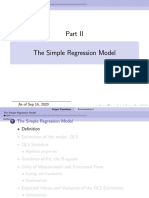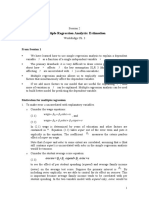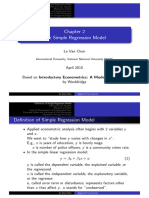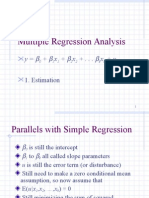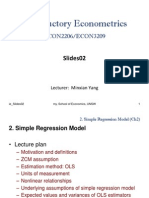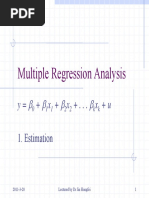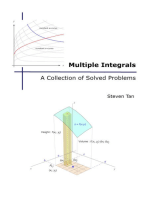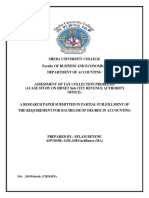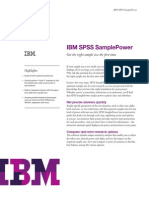Ch.2 The Simple Regression Model
Uploaded by
RRHMMCh.2 The Simple Regression Model
Uploaded by
RRHMMChapter 02
Ch.2 The simple regression model
1. Definition of the simple regression model
The Simple Regression Model 2. Deriving the OLS estimates
3. Mechanics of OLS
4. Units of measurement & functional form
y = 0 + 1x + u
5. Expected values & variances of OLSE
6. Regression through the origin
Econometrics 1 Econometrics 2
2.1 Definition of the model
Equation (2.1), y = 0 + 1x + u, defines the
Simple Regression model.
In the model, we typically refer to
y as the Dependent Variable
x as the Independent Variable
s as parameters, and
u as the error term.
Econometrics 3 Econometrics 4
The Concept of Error Term A Simple Assumption for u
u represents factors other than x that affect y. The average value of u, the error term, in
If the other factors in u are held fixed, so that the population is 0. That is, E(u) = 0.
u = 0, then y = 1x. This is not a restrictive assumption, since we
Ex. 2.1: yield = 0 + 1fertilizer + u (2.3) can always use 0 to normalize E(u) to 0.
u includes land quality, rainfall, etc. To draw ceteris paribus conclusions about
Ex. 2.2: wage = 0 + 1educ + u (2.4) how x affects y, we have to hold all other
factors (in u) fixed.
u includes experience, ability, tenure, etc.
Econometrics 5 Econometrics 6
Simple Regression Model 1
Chapter 02
E(y|x) as a linear function of x, where for any x
Zero Conditional Mean the distribution of y is centered about E(y|x)
y
We need to make a crucial assumption
f(y)
about how u and x are related.
We want it to be the case that knowing
something about x does not give us any . E(y|x) = + x
0 1
information about u, so that they are
completely unrelated. That is, that .
E(u|x) = E(u) = 0 (2.5&2.6), which implies
E(y|x) = 0 + 1x (PRF) (2.8)
x1 x2 x
Econometrics 7 Econometrics 8
Population regression line, sample data points
2.2 Deriving the OLSE and the associated error terms
y E(y|x) = 0 + 1x
Basic idea of regression is to estimate the y4 .
u4 {
population parameters from a sample.
Let {(xi,yi): i = 1, …, n} denote a random y3 .} u3
u {.
sample of size n from the population. y2
2
For each observation in this sample, it will
be the case that
yi = 0 + 1xi + ui. (2.9) y1 .} u1
x1 x2 x3 x4 x
Econometrics 9 Econometrics 10
Deriving OLSE using MM Cont. Deriving OLSE using MM
To derive the OLS estimates, we need to Since u = y – 0 – 1x, we can rewrite;
realize that our main assumption of E(u) = E(y – 0 – 1x) = 0 (2.12)
E(u|x) = E(u) = 0 also implies that E(xu) = E[x(y – 0 – 1x)] = 0 (2.13)
Cov(x,u) = E(xu) = 0
These are called moment restrictions
Because Cov(X,Y) = E(XY) – E(X)E(Y) (B.27)
The approach to estimation implies imposing the
Now we prepare 2 restrictions to estimate s. population moment restrictions on the sample
E(u) = 0 (2.10) moments. It means, a sample estimator of E(X),
E(xu) = 0 (2.11) the mean of a population distribution, is simply
the arithmetic mean of the sample.
Econometrics 11 Econometrics 12
Simple Regression Model 2
Chapter 02
More Derivation of OLS Cont. More Derivation of OLS
Given the definition of a sample mean, and
We want to choose values of the parameters properties of summation, we can rewrite the first
that will ensure that the sample versions of condition as follows
our moment restrictions are true y ˆ0 ˆ1 x (2.16) or ˆ0 y ˆ1 x (2.17)
The sample versions are as follows:
So the OLS estimated slope is
n
n 1 yi ˆ0 ˆ1 xi 0 (2.14)
n
i 1 x x y i i y
ˆ1 i 1
n (2.19)
n 1 xi yi ˆ0 ˆ1 xi 0 (2.15)
n
xi x
2
i 1 i 1
Econometrics 13 Econometrics 14
Summary of OLS slope estimate More OLS
The slope estimate is the sample Intuitively, OLS is fitting a line through the
covariance between x and y divided by the sample points such that the sum of squared
sample variance of x. residuals is as small as possible, hence the
If x and y are positively (negatively) term is called least squares.
correlated, the slope will be positive The residual, û, is an estimate of the error
(negative). term, u, and is the difference between the
x needs to vary in our sample. fitted line (sample regression function) and
See (2.18) & Figure (2.3) the sample point.
Econometrics 15 Econometrics 16
Sample regression line, sample data points
and the associated estimated error terms Alternate approach to derivation
y
y4 . Given the intuitive idea of fitting a line, we
û4 {
can set up a formal minimization problem.
uˆ y
yˆ ˆ 0 ˆ1 x n n 2
ˆ0 ˆ1 xi
2
i i (2.22)
y3 .} û3 i 1 i 1
y2
û2 {
.
The first order conditions, which are the
almost same as (2.14) & (2.15),
y
n n
y1 .} û1 i xi yi ˆ0 ˆ1 xi 0
ˆ0 ˆ1 xi 0,
i 1 i 1
x1 x2 x3 x4 x
Econometrics 17 Econometrics 18
Simple Regression Model 3
Chapter 02
2.3 Properties of OLS Cont. Algebraic Properties
Algebraic Properties of OLS 2. The sample covariance between the
regressors and the OLS residuals is zero
1. The sum of the OLS residuals is zero. n
Thus, the sample average of the OLS x uˆ
i 1
i i 0 ( 2.31)
residuals is zero as well.
n
1 n 3. The OLS regression line always goes
uˆ
i 1
i 0 and thus,
n
uˆ
i 1
i 0 (2.30) through the mean of the sample
y ˆ0 ˆ1 x
Econometrics 19 Econometrics 20
Cont. Algebraic Properties Goodness-of-Fit
We can think of each observation as being made It’s useful we think about how well the
up of an explained part, and an unexplained part, sample regression line fits sample data.
yi yˆ i uˆi (2.32) Then we define the following : From (2.36),
y y SST (2.33) SSE SSR
2
i R2 1 (2.38).
yˆ y SSE (2.34)
i
2 SST SST
R2 indicates the fraction of the sample
uˆ SSR (2.35)
2
i
variation in yi that is explained by the
Then, SST SSE SSR (2.36) model.
Econometrics 21 Econometrics 22
2.4 Measurement Units & Function Form 2.5 Means & Variance of OLSE
If we use the model y* = 0* + 1* x* + u* Now, we view ̂ i as estimators for the parameters
instead of y = 0 + 1 x + u, we get i that appears in the population, which means
c properties of the distributions of ̂ i over different
ˆ0* cˆ0 and ˆ1* ˆ1 random samples from the population.
d
where y* = c y and x* = d x. Similarly, Unbiasedness of OLS
y x y Unbiased estimator: An estimator whose expected
ˆ1* ˆ1 value (or mean of its sampling distribution) equals
x y x the population value (regardless of the population
where y* = ln y and x* = ln x. value).
Econometrics 23 Econometrics 24
Simple Regression Model 4
Chapter 02
Cont. Unbiasedness of OLS Cont. Unbiasedness of OLS
Assumption for unbiasedness In order to think about unbiasedness, we
1. Linear in parameters as y = 0 + 1x + u need to rewrite our estimator in terms of
2. Random sampling {(xi, yi): i = 1, 2, …, n}, the population parameter.
xi x yi x x u
ˆ1
Thus, yi = 0 + 1xi + ui
1 i i
(2.49), (2.52)
3. Sample variation in the xi, thus (x x)
i
2
(x x) i
2
(x x)
i
2
0
then E ˆ1 1
x x E (u
i
| x ) 1
(2.53)
(x x) 2 i
4. Zero conditional mean, E(u|x) = 0 i
* we can also get E ( ˆ0 ) 0 in the same way.
Econometrics 25 Econometrics 26
Unbiasedness Summary Variances of the OLS Estimators
The OLS estimates of 1 and 0 are Now we know that the sampling
unbiased. distribution of our estimate is centered
Proof of unbiasedness depends on our 4 around the true parameter.
assumptions – if any assumption fails, then We want to think about how spread out this
OLS is not necessarily unbiased. distribution is.
Remember unbiasedness is a description of It is much easier to think about this variance
the estimator – in a given sample our under an additional assumption, so assume
estimate may be “near” or “far” from the
true parameter.
5. Var(u|x) = 2 (Homoskedasticity)
Econometrics 27 Econometrics 28
Cont. Variance of OLSE Homoskedastic Case
y
2 is also the unconditional variance, called f(y|x)
the error variance, since
Var(u|x) = E(u2|x) - [E(u|x)]2
E(u|x) = 0, so = E(u |x) = E(u ) = Var(u)
2 2 2
. E(y|x) = + x
0 1
And , the square root of the error variance, is .
called the standard deviation of the error.
Then we can say
E(y|x)=0 + 1x and Var(y|x) = 2
x1 x2
Econometrics 29 Econometrics 30
Simple Regression Model 5
Chapter 02
Heteroskedastic Case Cont. Variance of OLSE
f(y|x)
2
Var ( ˆ1 ) ( 2 . 57 )
(x i x )2
. The larger the error variance, 2, the larger
. E(y|x) = 0 + 1x the variance of the slope estimate.
. The larger the variability in the xi, the
smaller the variance of the slope estimate.
As a result, a larger sample size should
x1 x2 x3 x decrease the variance of the slope estimate.
Econometrics 31 Econometrics 32
Estimating the Error Variance Cont. Error Variance Estimate
We don’t know what is the error variance, uˆi yi ˆ0 ˆ1 xi
2, because we don’t observe the errors, ui.
0 1 xi ui ˆ0 ˆ1 xi
What we observe are only the residuals, ûi, i
u ˆ ˆ x
0 0 1 1 i
not the errors, ui.
Then, an unbiased estimator of 2 is
1
n 2 i
So we can use the residuals to form an
estimate of the error variance.
ˆ 2 uˆ 2 (2.61)
Econometrics 33 Econometrics 34
Cont. Error Variance Estimate 2.6 Regression through the Origin
Now, consider the model without a intercept:
ˆ ˆ 2 Standard error of the regression ~ ~
y 1 x (2.63).
recall that s.d. ˆ Var ( ˆ ) Solving the FOC to the minimization
If we substitute ˆ for , then we have problem, OLS estimated slope is
the standard error of ˆ ,
1 i 2 i (2.66).
1
~ xy
xi
ˆ 2
se ˆ1
i x )2
( x * Recall that a intercept can always normalize E(u)
to 0 in the model with 0.
Econometrics 35 Econometrics 36
Simple Regression Model 6
You might also like
- Assignment 2 - HLTH 605b - Fall 2020 (100 Marks)No ratings yetAssignment 2 - HLTH 605b - Fall 2020 (100 Marks)2 pages
- Applied Regression - HW1 - JP, Savio, Leila, Mohan100% (1)Applied Regression - HW1 - JP, Savio, Leila, Mohan18 pages
- As of Sep 16, 2020: Seppo Pynn Onen Econometrics INo ratings yetAs of Sep 16, 2020: Seppo Pynn Onen Econometrics I52 pages
- The Simple Regression Model: DR Jin Hongfei 1No ratings yetThe Simple Regression Model: DR Jin Hongfei 141 pages
- Multiple Regression Analysis: y + X + X + - . - X + UNo ratings yetMultiple Regression Analysis: y + X + X + - . - X + U26 pages
- Ordinary Least Squares: Rómulo A. ChumaceroNo ratings yetOrdinary Least Squares: Rómulo A. Chumacero50 pages
- ECO 401 Econometrics: SI 2021 Week 2, 14 September100% (1)ECO 401 Econometrics: SI 2021 Week 2, 14 September47 pages
- Econ 329 - Statistical Properties of The Ols Estimator: Sanjaya DesilvaNo ratings yetEcon 329 - Statistical Properties of The Ols Estimator: Sanjaya Desilva12 pages
- Multiple Regression Analysis: Võ Đ C Hoàng VũNo ratings yetMultiple Regression Analysis: Võ Đ C Hoàng Vũ20 pages
- Introductory Econometrics: Prachi Singh & Partha BandopadhyayNo ratings yetIntroductory Econometrics: Prachi Singh & Partha Bandopadhyay18 pages
- Gujarati D, Porter D, 2008: Basic Econometrics 5Th Edition Summary of Chapter 3-5No ratings yetGujarati D, Porter D, 2008: Basic Econometrics 5Th Edition Summary of Chapter 3-564 pages
- Multiple Regression Analysis: y + X + X + - . - X + UNo ratings yetMultiple Regression Analysis: y + X + X + - . - X + U28 pages
- Multiple Regression Analysis: y + X + X + - . - X + UNo ratings yetMultiple Regression Analysis: y + X + X + - . - X + U43 pages
- Student Solutions Manual to Accompany Economic Dynamics in Discrete Time, secondeditionFrom EverandStudent Solutions Manual to Accompany Economic Dynamics in Discrete Time, secondedition4.5/5 (2)
- Student's Solutions Manual and Supplementary Materials for Econometric Analysis of Cross Section and Panel Data, second editionFrom EverandStudent's Solutions Manual and Supplementary Materials for Econometric Analysis of Cross Section and Panel Data, second editionNo ratings yet
- Faculty of Psychology Bachelor of Science (Psychology) Curriculum Structure Document Academic YearNo ratings yetFaculty of Psychology Bachelor of Science (Psychology) Curriculum Structure Document Academic Year97 pages
- Psychology 311 - Introduction To Statistics Lab Manual: Diane Lane Washington State University VancouverNo ratings yetPsychology 311 - Introduction To Statistics Lab Manual: Diane Lane Washington State University Vancouver34 pages
- An Assessment of Data Analytics Application For Demnad and Supply Planning in The Textiles and Garment Industry - Ms. Nguyen Thi Quyen-St122736No ratings yetAn Assessment of Data Analytics Application For Demnad and Supply Planning in The Textiles and Garment Industry - Ms. Nguyen Thi Quyen-St12273648 pages
- KRUCIAL - All in One Delivery Web ApplicationNo ratings yetKRUCIAL - All in One Delivery Web Application9 pages
- A00-485 Dumps - Modeling Using SAS Visual StatisticsNo ratings yetA00-485 Dumps - Modeling Using SAS Visual Statistics14 pages
- Ibm Spss Samplepower: Get The Right Sample Size The First TimeNo ratings yetIbm Spss Samplepower: Get The Right Sample Size The First Time4 pages
- Microsoft Power Tools For Data Analysis Class Introduction Video100% (1)Microsoft Power Tools For Data Analysis Class Introduction Video16 pages
- Applied Regression - HW1 - JP, Savio, Leila, MohanApplied Regression - HW1 - JP, Savio, Leila, Mohan
- As of Sep 16, 2020: Seppo Pynn Onen Econometrics IAs of Sep 16, 2020: Seppo Pynn Onen Econometrics I
- Multiple Regression Analysis: y + X + X + - . - X + UMultiple Regression Analysis: y + X + X + - . - X + U
- ECO 401 Econometrics: SI 2021 Week 2, 14 SeptemberECO 401 Econometrics: SI 2021 Week 2, 14 September
- Econ 329 - Statistical Properties of The Ols Estimator: Sanjaya DesilvaEcon 329 - Statistical Properties of The Ols Estimator: Sanjaya Desilva
- Introductory Econometrics: Prachi Singh & Partha BandopadhyayIntroductory Econometrics: Prachi Singh & Partha Bandopadhyay
- Gujarati D, Porter D, 2008: Basic Econometrics 5Th Edition Summary of Chapter 3-5Gujarati D, Porter D, 2008: Basic Econometrics 5Th Edition Summary of Chapter 3-5
- Multiple Regression Analysis: y + X + X + - . - X + UMultiple Regression Analysis: y + X + X + - . - X + U
- Multiple Regression Analysis: y + X + X + - . - X + UMultiple Regression Analysis: y + X + X + - . - X + U
- Student Solutions Manual to Accompany Economic Dynamics in Discrete Time, secondeditionFrom EverandStudent Solutions Manual to Accompany Economic Dynamics in Discrete Time, secondedition
- Multiple Integrals, A Collection of Solved ProblemsFrom EverandMultiple Integrals, A Collection of Solved Problems
- Student's Solutions Manual and Supplementary Materials for Econometric Analysis of Cross Section and Panel Data, second editionFrom EverandStudent's Solutions Manual and Supplementary Materials for Econometric Analysis of Cross Section and Panel Data, second edition
- Faculty of Psychology Bachelor of Science (Psychology) Curriculum Structure Document Academic YearFaculty of Psychology Bachelor of Science (Psychology) Curriculum Structure Document Academic Year
- Psychology 311 - Introduction To Statistics Lab Manual: Diane Lane Washington State University VancouverPsychology 311 - Introduction To Statistics Lab Manual: Diane Lane Washington State University Vancouver
- An Assessment of Data Analytics Application For Demnad and Supply Planning in The Textiles and Garment Industry - Ms. Nguyen Thi Quyen-St122736An Assessment of Data Analytics Application For Demnad and Supply Planning in The Textiles and Garment Industry - Ms. Nguyen Thi Quyen-St122736
- A00-485 Dumps - Modeling Using SAS Visual StatisticsA00-485 Dumps - Modeling Using SAS Visual Statistics
- Ibm Spss Samplepower: Get The Right Sample Size The First TimeIbm Spss Samplepower: Get The Right Sample Size The First Time
- Microsoft Power Tools For Data Analysis Class Introduction VideoMicrosoft Power Tools For Data Analysis Class Introduction Video









